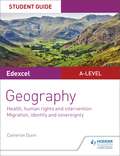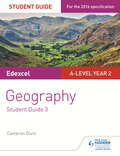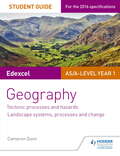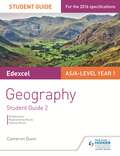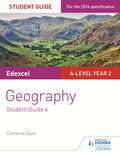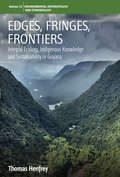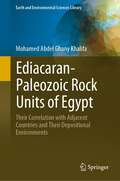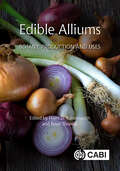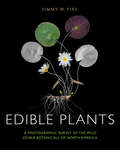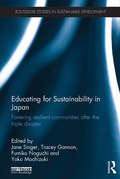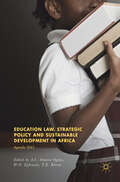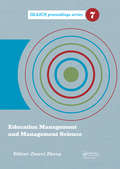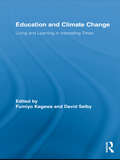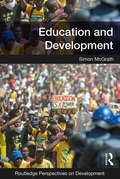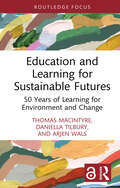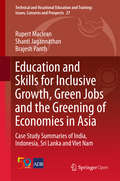- Table View
- List View
Edexcel A-level Geography Student Guide 5: Health Human Rights Epub
by Cameron DunnExam Board: EdexcelLevel: AS/A-levelSubject: GeographyFirst teaching: September 2016First exams: Summer 2017 (AS), Summer 2018 (A-level)Reinforce students' geographical understanding throughout their course; clear topic summaries with sample questions and answers help students improve their exam technique and achieve their best.Written by a teacher with extensive examining experience, this guide:- Helps students identify what they need to know with a concise summary of the topics examined at AS and A-level- Consolidates understanding through assessment tips and knowledge-check questions- Offers opportunities for students to improve their exam technique by consulting sample graded answers to exam-style questions- Develops independent learning and research skills- Provides the content students need to produce their own revision notes
Edexcel A-level Year 2 Geography Student Guide 3: The Water Cycle and Water Insecurity; The Carbon Cycle and Energy Security; Superpowers
by Cameron Dunn Michael WitherickReinforce students' geographical understanding throughout their course; clear topic summaries with sample questions and answers help students improve their exam technique and achieve their best.Written by a teacher with extensive examining experience, this guide:- Helps students identify what they need to know with a concise summary of the topics examined at AS and A-level- Consolidates understanding through assessment tips and knowledge-check questions- Offers opportunities for students to improve their exam technique by consulting sample graded answers to exam-style questions- Develops independent learning and research skills- Provides the content students need to produce their own revision notes
Edexcel A-level Year 2 Geography Student Guide 3: The Water Cycle and Water Insecurity; The Carbon Cycle and Energy Security; Superpowers
by Cameron Dunn Michael WitherickExam board: EdexcelLevel: A-levelSubject: GeographyFirst teaching: September 2016First exams: Summer 2017Reinforce students' geographical understanding throughout their course; clear topic summaries with sample questions and answers help students improve their exam technique and achieve their best.Written by a teacher with extensive examining experience, this guide:- Helps students identify what they need to know with a concise summary of the topics examined at AS and A-level- Consolidates understanding through assessment tips and knowledge-check questions- Offers opportunities for students to improve their exam technique by consulting sample graded answers to exam-style questions- Develops independent learning and research skills- Provides the content students need to produce their own revision notes
Edexcel AS/A-level Geography Student Guide 1: Tectonic Processes and Hazards; Landscape systems, processes and change
by Cameron DunnReinforce students' geographical understanding throughout their course; clear topic summaries with sample questions and answers help students improve their exam technique and achieve their best.Written by a teacher with extensive examining experience, this guide:- Helps students identify what they need to know with a concise summary of the topics examined at AS and A-level- Consolidates understanding through assessment tips and knowledge-check questions- Offers opportunities for students to improve their exam technique by consulting sample graded answers to exam-style questions- Develops independent learning and research skills- Provides the content students need to produce their own revision notes
Edexcel AS/A-level Geography Student Guide 1: Tectonic Processes and Hazards; Landscape systems, processes and change
by Cameron DunnExam Board: EdexcelLevel: AS/A-levelSubject: GeographyFirst Teaching: September 2016First Exam: June 2017Reinforce students' geographical understanding throughout their course; clear topic summaries with sample questions and answers help students improve their exam technique and achieve their best.Written by a teacher with extensive examining experience, this guide:- Helps students identify what they need to know with a concise summary of the topics examined at AS and A-level- Consolidates understanding through assessment tips and knowledge-check questions- Offers opportunities for students to improve their exam technique by consulting sample graded answers to exam-style questions- Develops independent learning and research skills- Provides the content students need to produce their own revision notes
Edexcel AS/A-level Geography Student Guide 2: Globalisation; Shaping places
by Cameron DunnExam Board: EdexcelLevel: AS/A-levelSubject: GeographyFirst Teaching: September 2016First Exam: September 2017Reinforce students' geographical understanding throughout their course; clear topic summaries with sample questions and answers help students improve their exam technique and achieve their best.Written by a teacher with extensive examining experience, this guide:- Helps students identify what they need to know with a concise summary of the topics examined at AS and A-level- Consolidates understanding through assessment tips and knowledge-check questions- Offers opportunities for students to improve their exam technique by consulting sample graded answers to exam-style questions- Develops independent learning and research skills- Provides the content students need to produce their own revision notes
Edexcel AS/A-level Geography Student Guide 2: Globalisation; Shaping places
by Cameron DunnExam Board: EdexcelLevel: AS/A-levelSubject: GeographyFirst Teaching: September 2016First Exam: June 2017Reinforce students' geographical understanding throughout their course; clear topic summaries with sample questions and answers help students improve their exam technique and achieve their best.Written by a teacher with extensive examining experience, this guide:- Helps students identify what they need to know with a concise summary of the topics examined at AS and A-level- Consolidates understanding through assessment tips and knowledge-check questions- Offers opportunities for students to improve their exam technique by consulting sample graded answers to exam-style questions- Develops independent learning and research skills- Provides the content students need to produce their own revision notes
Edexcel AS/A-level Geography Student Guide 4: Geographical skills; Fieldwork; Synoptic skills
by David Redfern Cameron DunnReinforce students' geographical understanding throughout their course; clear topic summaries with sample questions and answers help students improve their exam technique and achieve their best.Written by a teacher with extensive examining experience, this guide:- Helps students identify what they need to know with a concise summary of the topics examined at AS and A-level- Consolidates understanding through assessment tips and knowledge-check questions- Offers opportunities for students to improve their exam technique by consulting sample graded answers to exam-style questions- Develops independent learning and research skills- Provides the content students need to produce their own revision notes
Edexcel AS/A-level Geography Student Guide: Geographical skills; Fieldwork; Synoptic skills
by David Redfern Cameron DunnReinforce students' geographical understanding throughout their course; clear topic summaries with sample questions and answers help students improve their exam technique and achieve their best.Written by a teacher with extensive examining experience, this guide:- Helps students identify what they need to know with a concise summary of the topics examined at AS and A-level- Consolidates understanding through assessment tips and knowledge-check questions- Offers opportunities for students to improve their exam technique by consulting sample graded answers to exam-style questions- Develops independent learning and research skills- Provides the content students need to produce their own revision notes
Edge of Empire: Postcolonialism and the City
by Jane M. JacobsEdge of Empire examines struggles over urban space in three contemporary first world cities in an attempt to map the real geographies of colonialism and postcolonialism as manifest in modern society. From London, the one-time heart of the empire, to Perth and Brisbane, scenes of Aboriginal claims for the sacred in the space of the modern city, Jacobs emphasises the global geography of the local and unravels the spatialised cultural politics of postcolonial processes. Edge of Empire forms the basis for understanding imperialism over space and time, and is a recognition of the unruly spatial politics of race and nation, nature and culture, past and present.
Edge of Morning: Native Voices Speak for the Bears Ears
by Jacqueline KeelerIn support of tribal efforts to protect the Bears Ears, Native writers bear testimony to the fragile and essential nature of this sacred landscape in America’s remote red rock country. Through poem and essay, these often-ignored voices explore the ways many native people derive tradition, sustenance, and cultural history from the Bears Ears.
Edges, Fringes, Frontiers: Integral Ecology, Indigenous Knowledge and Sustainability in Guyana (Environmental Anthropology and Ethnobiology #23)
by Thomas HenfreyBased on an ethnographic account of subsistence use of Amazonian forests by Wapishana people in Guyana, Edges, Frontiers, Fringes examines the social, cultural and behavioral bases for sustainability and resilience in indigenous resource use. Developing an original framework for holistic analysis, it demonstrates that flexible interplay among multiple modes of environmental understanding and decision-making allows the Wapishana to navigate social-ecological complexity successfully in ways that reconcile short-term material needs with long-term maintenance and enhancement of the resource base.
Ediacaran-Paleozoic Rock Units of Egypt: Their Correlation with Adjacent Countries and Their Depositional Environments (Earth and Environmental Sciences Library)
by Mohamed Abdel KhalifaThis book presents the following geological contributions in Ediacaran and Paleozoic rocks. 1) It introduces four new rock units for the first time, the Ediacaran El Urf Formation (volcanoclastic sediments in the central Eastern Desert), the Ediacaran Abu Haswa Formation (stromatolitic dolostone in southwestern Sinai), the Early Permian Wadi Dome Formation (mixed clastics and carbonates in the west of Suez Gulf) and the Early Permian Misawag Formation (in the subsurface, northwestern Desert), 2) making correlation of the Ediacaran rock units with the corresponding rock units in Libya, Jordan, Iraq and Saudi Arabia, 3) linking the exposed Paleozoic rock units with their equivalent rock units in subsurface in northwestern desert, 4) correlating the Paleozoic rock units with the equivalent rock units in adjacent countries, e. g. Libya, Jordan, Iraq and Saudi Arabia, 5) manifesting the possible depositional environments of the Ediacaran and Paleozoic rock units. Additionally, it offers an important unique geological information about the Ediacaran and Paleozoic rock units in Egypt. It unifies the nomenclature of Paleozoic rock units that take numerous names for the same geological time. It obsoletes the formation names that do not follow the rules of the North American stratigraphic code (1983) for rock units’ nomenclature. It provides the target audience illustrations, e.g. field photographs for the exposed rock units that save efforts and time for audience (undergraduate, post-graduate, researchers and professional) to reach to the original localities of each rock units. It provides the audience with schematic diagrams that exhibit the link between the exposed and subsurface rock units all over the Egyptian territory. It describes the following topics of each rock unit: definition, stratigraphic contact, lithological characteristics, faunal and floral associations that are used for the identification of the possible age, correlation with corresponding rock units in adjacent countries, e.g. Libya, Jordan, Iraq and Saudi Arabia and the possible depositional environments for each rock units. The book is a fundamental source of an updated version of the information in the field to the undergraduate, graduate, researchers, professional, practitioners and policy planning elsewhere.
Edible Alliums: Botany, Production and Uses (Botany, Production and Uses)
by Brian Thomas Haim D. RabinowitchAllium crops include more than 30 species, many of which (for e.g. onions, shallots, garlic, leeks, bunching onions, and chives) are of economic importance. Bulb onions rank second only to tomatoes in terms of global production. Alliums are farmed and harvested in a range of climatic conditions worldwide, forming important parts of local diets. This book provides a comprehensive review of major and minor Allium crops from scientific and horticultural perspectives. It broadly covers modern biology (including genetics and breeding), propagation, production, processing, and nutritional and health benefits. Edible Alliums contains coverage of: Both major and minor Allium crops. Improving crop production, quality, and sustainability of Allium crops. Advances in digital technologies, 'omics' research and gene editing. Objectives for improving crop performance, such as integrated crop management, the plant-soil interface, improving propagation materials, post-harvest quality and reducing waste. This is an essential resource for scholars, researchers and students in plant science and agriculture, in addition to molecular biologists, plant breeders, agronomists, consultants, and extension specialists.
Edible Italian Garden
by Rosalind CreasyCreasy offers recommendations for selecting and growing the best varieties ofItalian herbs and vegetables: basil, broccoli rabe, fava beans, and tomatoes. Over 90 color illustrations.
Edible Plants: A Photographic Survey of the Wild Edible Botanicals of North America
by Jimmy FikeFor over a decade, artist Jimmy Fike traveled across the continental United States in an epic effort to photograph wild edible flora. Edible Plants is the culmination of that journey, featuring over 100 photographs that Fike has selectively colorized to highlight the comestible part of the plant. While the images initially appear to be scientific illustrations or photograms from the dawn of photography when plants were placed directly on sensitized paper and exposed under the sun, a closer look reveals, according to Liesl Bradner of the Los Angeles Times, "haunting [and] eerily beautiful" photographs. Beyond instilling wonder, Fike's contemporary, place-based approach to landscape photography emphasizes our relationship to the natural world, reveals food sources, and encourages environmental stewardship. His clever and beautiful method makes it easy to identify both the specimen and its edible parts and includes detailed descriptions about the plant's wider purposes as food and medicine.Sumptuously illustrated and delightfully informative, Edible Plants is the perfect gift for anyone curious about unlocking the secrets of native North American plants.
Edible Wild Plants for Beginners: The Essential Edible Plants and Recipes to Get Started
by Althea PressDig up a whole new culinary world with this New York Times best-selling field guide to foragingMost of us "forage" for food in the aisles of well-lit grocery stores. But there are delicious edible plants for the taking right outside your door! This all-in-one reference shows you how to identify 31 of the most common edible wild plants in North America, from California to Connecticut.Gather your gear—Dive into edible plant history and foraging FAQs, and learn what tools you'll need before you head out.Spot the snacks—Find photos, descriptions, distinguishing characteristics, and common uses for 31 edible wild plants—from arrowroot to wild rose.Recipes and remedies—Learn to use wild plants in everything from curry and cookies to bug bite balm and bath soaks.Stay safe—This book includes foraging guidelines that are vital to your safety. It's recommended you read it in its entirety before you explore.Make the most of what Mother Nature has to offer with Edible Wild Plants for Beginners.
Edible Wild Plants, Volume 2: Wild Foods from Foraging to Feasting (Wild Food Adventure)
by John KallasThis second volume of Edible Wild Plants adds 18 additional plants, their relatives, and look-a-likes, in 15 plant chapters, to the overall collection of plants covered between the two volumes in The Wild Food Adventure Series. This book makes it delightfully exciting to learn about and experiment with known wild foods that will be useful to all, from beginners to advanced foragers. This book features plants in five flavor categories―foundation, tart, pungent or peppery, bitter, and distinctive & sweet. Organizing this way helps readers use the plants in pleasing and predictable ways. Imagine frequently including cattail, nettles, pokeweed, marsh mallow, daylily, wild radish, and everlasting pea in your meal planning knowing that you acquired these plants from your own foraging adventures. There is also a section devoted to identifying and knowing poison hemlock, often confused with wild carrot in certain stages of development. John Kallas and his Wild Food Adventure book series are here to help you learn quickly, process intelligently, and genuinely enjoy what you are eating.
Educating for Sustainability in Japan: Fostering resilient communities after the triple disaster (Routledge Studies in Sustainable Development)
by Jane Singer Tracey Gannon Fumiko Noguchi Yoko MochizukiEducating for Sustainable Development (ESD) approaches are holistic and interdisciplinary, values-driven, participatory, multi-method, locally relevant and emphasize critical thinking and problem-solving. This book explains how ESD approaches work in the Japanese context; their effects on different stakeholders; and their ultimate potential contribution to society in Japan. It considers ESD in both formal and informal education sectors, recognizing that even when classroom learning takes place it must be place-based and predicated on a specific community context. The book explores not only ‘Why ESD’, but why and how ESD in Japan has gained importance in the past decade and more recently in the wake of the triple disaster of March 2011. It considers how ESD can help Japan recover and adapt to disasters and take initiative in building more resilient and sustainable communities. This volume asks the questions: What are some examples of positive contributions by ESD to sustainability in Japan? What is the role of ESD in Japan in activating people to demand and work towards change? How can schools, universities and non-governmental organizations link with communities to strengthen civic awareness and community action? After an introduction that elucidates the roots and recent promotion of ESD in Japan, part one of this volume looks at the formal education sector in Japan, while part two examines community-based education and sustainability initiatives. The latter revisits the Tohoku region five years on from the events of March 2011, to explore recovery and revitalization efforts by schools, NGOs and residents. This is an invaluable book for postgraduate students, researchers, teachers and policy makers working on ESD.
Education Law, Strategic Policy and Sustainable Development in Africa: Agenda 2063
by A. C. Onuora-Oguno W. O. Egbewole T. E. KlevenThis book outlines the findings and suggestions of the Law and Society Association’s International Research Collaborations, which focused on the African Union’s Agenda 2063. This outlined the ideal Africa aspired to by the year 2063: ‘the Africa we want’. The authors examine socio-economic rights issues and their impact on developing a strong educational agenda that can drive Africa to realize Agenda 2063. As Africa’s development has remained slow in the face of many challenges, the need to embrace good governance, rule of law and human rights obligations are major tools to realize the continent’s potential. The project focuses in particular on the central place of education law and policy in achieving the goals of Agenda 2063.
Education Management and Management Science: Proceedings of the International Conference on Education Management and Management Science (ICEMMS 2014), August 7-8, 2014, Tianjin, China (IRAICS Proceedings)
by Dawei ZhengThis proceedings volume contains selected papers presented at the 2014 International Conference on Education Management and Management Science (ICEMMS 2014), held August 7-8, 2014, in Tianjin, China. The objective of ICEMMS2014 is to provide a platform for researchers, engineers, academicians as well as industrial professionals from all over the wo
Education and Climate Change: Living and Learning in Interesting Times (Routledge Research in Education)
by David Selby Fumiyo KagawaThere is widespread consensus in the international scientific community that climate change is happening and that abrupt and irreversible impacts are already set in motion. What part does education have to play in helping alleviate rampant climate change and in mitigating its worst effects? In this volume, contributors review and reflect upon social learning from and within their fields of educational expertise in response to the concerns over climate change. They address the contributions the field is currently making to help preempt and mitigate the environmental and social impacts of climate change, as well as how it will continue to respond to the ever changing climate situation. With a special foreword by Desmond Tutu, Archbishop Emeritus of Cape Town.
Education and Development: Education, Training And Development In Africa (Routledge Perspectives on Development)
by Simon McGrathThis title explores the place of education in development debates and provides a systematic as well as a theoretical overview of the main approaches to education and development. It emphasises the fact that education is profoundly shaped by national and local cultures even if many issues are shared across institutions in different locations. Education and Development discusses different theoretical accounts from different disciplinary traditions to help students understand the complexity of the overall debate. The text does not shy away from discussions of education’s negative impacts, and insists that an account of education must include consideration of early childhood development, adult, vocational and higher education, as well as the growing range of informal and distance forms. It includes chapters on human capital, human rights and human development, and on education, gender and development, and draws on examples from a wide range of countries and regions such as India, Hong Kong, Kenya and South Africa. The book has a well-developed pedagogy including text boxes, chapter summaries, key questions, links to websites and videos, and annotated further reading sections. Particular attention is paid to ensuring that a plurality of voices, contexts and educational sub-sectors are represented in the boxes, weblinks and references. Education and Development provides an introductory overview to the field, aimed at the undergraduate level, while critically engaging with key themes and questions. The book will also be of interest to development practitioners, policymakers, entrepreneurs and corporate employees engaged in aspects of education and development work.
Education and Learning for Sustainable Futures: 50 Years of Learning for Environment and Change (Routledge Research in Education, Society and the Anthropocene)
by Daniella Tilbury Thomas Macintyre Arjen WalsResponding to growing interest in the sustainable development goals (SDGs) and global concern over climate change, this volume provides an analysis of how our understanding of the relationship between environment and education has evolved during the past 50 years.Spanning from the 1972 United Nations Conference on the Human Environment through to the present day, chapters examine whether our approach to education about environmental sustainability is enacting effective change. Examining the evolution of educational approaches to environmental learning, contexts, and themes, this book moves through the decades, from the 1970s until the 2020s, tracking the impact of historical events and shifting sustainability discourses within education. Through historical, research-based analyses, this book recognises patterns, trends, and countertrends that help critically (re)assess the potential of education in creating a world that is more sustainable than current scientific predictions estimate.Proposing a set of key considerations for the future of environmental education, this accessible book will be of value to scholars, researchers, policymakers, and practitioners working within sustainability education, environmental research and policy, and teacher education more broadly.
Education and Skills for Inclusive Growth, Green Jobs and the Greening of Economies in Asia: Case Study Summaries Of India, Indonesia, Sri Lanka And Viet Nam (Technical And Vocational Education And Training: Issues, Concerns And Prospects Ser. #27)
by Rupert Maclean Shanti Jagannathan Brajesh PanthThis book presents an overview of the main research findings and case studies concerning education and skills for inclusive growth, green jobs and the greening of economies. Focusing on India, Indonesia, Sri Lanka and Viet Nam, it discusses government and business sector responses to these issues and how Technical and Vocational Education and Training (TVET) systems and institutions are addressing both the renewal of curricula in the context of green growth dynamics, and patterns of training and skills development to meet demands. In addition, the book examines cross-country issues, concerns and prospects regarding education and skills for inclusive growth and green jobs for the four countries. These include critical themes and issues in the selected industry sectors triggering a demand for green jobs in the region; how industry is responding to those demands; areas impeding the transition from traditional to green practices; the importance of skills development; the role of TVET in addressing industry needs; and reasons for the slow response of TVET to green skills. While other studies conducted in Asia - and internationally - on the same topic have largely relied on secondary sources, this study conducted by the Asian Development Bank and the Education University of Hong Kong (ADB-EdUHK) is unique in that the findings, conclusions and recommendations reported on are based on primary data. As part of the study, TVET providers, business enterprises, policy makers and practitioners were surveyed using questionnaires and face-to-face interviews. In addition, workshops were held in each of the four countries to ascertain the views of key stakeholders in government, nongovernment organisations, members of the international development community, TVET providers and members of the business sector. The book also provides summaries of the case studies undertaken for India, Indonesia, Sri Lanka and Viet Nam. This book is open access under a CC BY license
